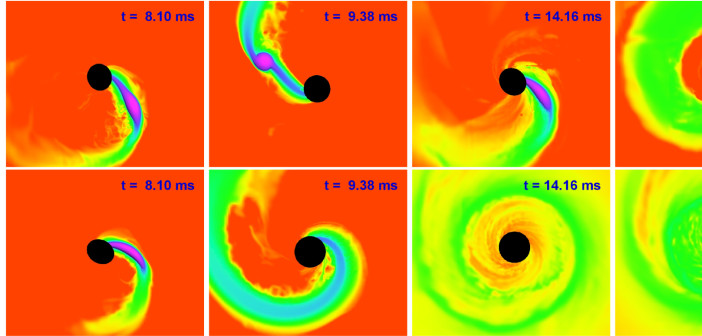When a neutron star (NS) has a glancing encounter with a black hole (BH), its spin has a significant effect on the outcome, according to new simulations run by William East of Stanford University and his collaborators.
Spotting an Eccentric Merger
In a traditional BH-NS merger, the two objects orbit each other quasi-circularly as they spiral in. But there’s another kind of merger that’s possible in high-density environments like galactic nuclei or globular clusters: a dynamical capture merger, in which a NS and BH pass each other just close enough that the gravity of the black hole “catches” the NS, leading the two objects to merge with very eccentric orbits.
During an eccentric merger, the NS can be torn apart — at which point some fraction of the tidally-disrupted material will escape the system, while some fraction instead accretes back onto the BH. Knowing these fractions is important for being able to model the expected electromagnetic signatures for the merger: the unbound material can power transients like kilonovae, whereas the accreting material may be the cause of short gamma-ray bursts. The amount of material available for events like these would change their observable strengths.
Testing the Effects of Spin
To see whether NS spin has an impact on the behavior of the merger, East and collaborators use a general-relativistic hydrodynamic code to simulate the glancing encounter of a BH and a NS with dimensionless spin between a=0 (non-spinning) and a=0.756 (rotation period of 1 ms). They also vary the separation of the first encounter.
The group finds that changing the NS’s spin can change a number of outcomes of the merger. To start with, it can affect whether the NS is captured by the BH, or if the encounter is glancing and then both objects carry on their merry way. And if the NS is trapped by the BH and torn apart, then the higher the NS’s spin, the more matter outside of the BH ends up unbound, instead of getting trapped into an accretion disk around the BH.
As a result of these simulations, the authors argue that the spin of NSs in dynamical capture mergers is crucially important for correctly modeling the observational signatures that might come out of them.
Citation:
William E. East et al. 2015 ApJ 807 L3 doi:10.1088/2041-8205/807/1/L3

